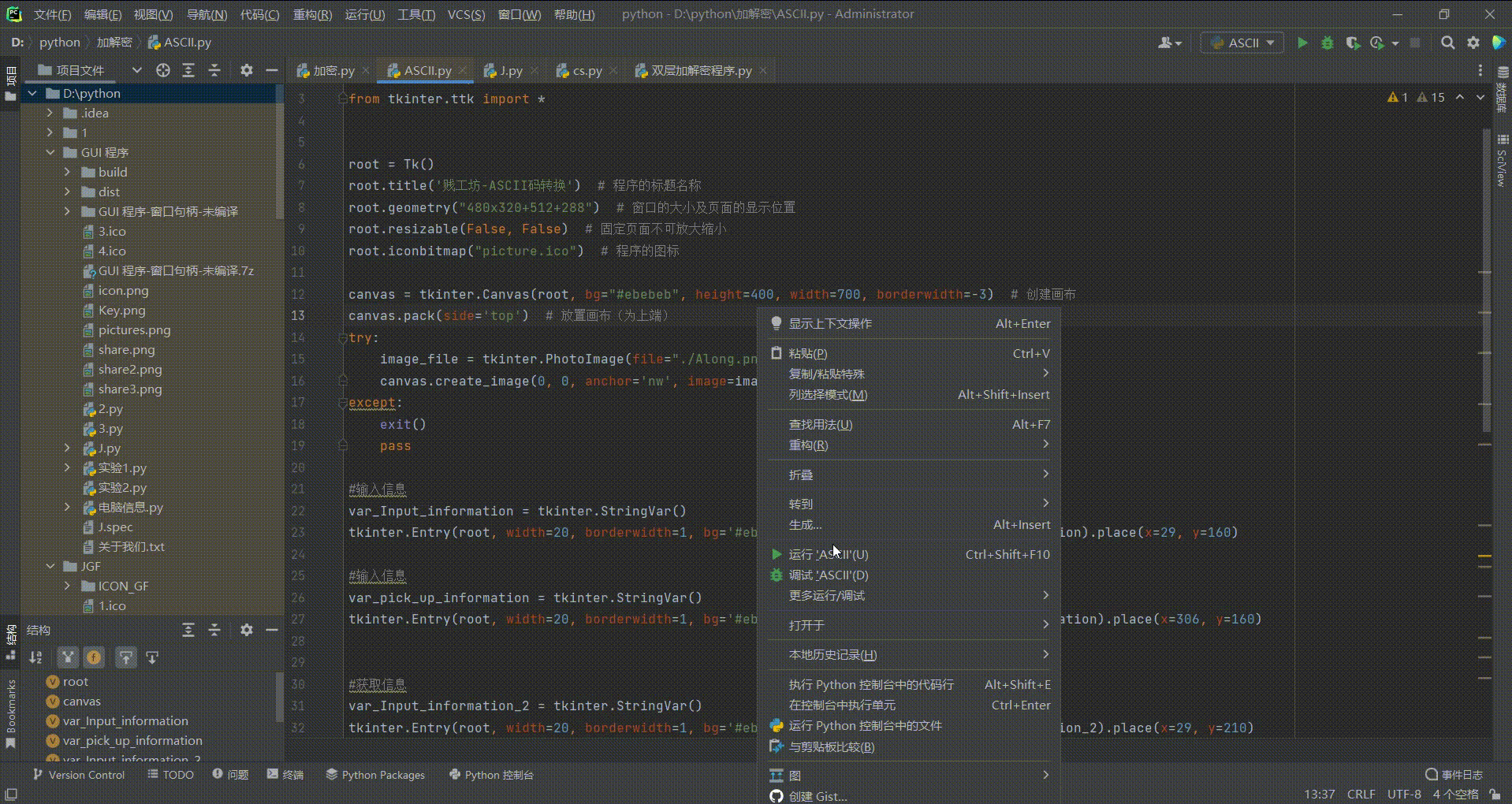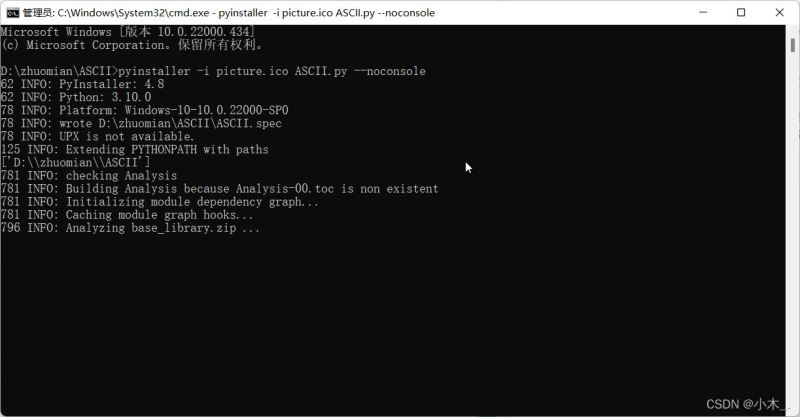这篇文章主要为大家展示了“如何使用Python制作ASCII码转换器”,内容简而易懂,条理清晰,希望能够帮助大家解决疑惑,下面让小编带领大家一起研究并学习一下“如何使用Python制作ASCII码转换器”这篇文章吧。
实现效果

使用 chr 和 ord 进行互转,
prtint(chr(98))
结果:b
print(ord(b))
结果:98
实现步骤
导入模块
import tkinterfrom tkinter import *from tkinter.ttk import *创建画布并更改背景颜色添加纹理图片,如果图片不存在则执行exit()进行退出程序
canvas = tkinter.Canvas(root, bg="#ebebeb", height=400, width=700, borderwidth=-3) # 创建画布canvas.pack(side='top') # 放置画布(为上端)try: image_file = tkinter.PhotoImage(file="./Along.png") # 加载图片文件 canvas.create_image(0, 0, anchor='nw', image=image_file) # 将图片置于画布上except: exit() pass添加输入框和信息框
#输入信息var_Input_information = tkinter.StringVar()tkinter.Entry(root, width=20, borderwidth=1, bg='#ebebeb', textvariable=var_Input_information).place(x=29, y=160) #输入信息var_pick_up_information = tkinter.StringVar()tkinter.Entry(root, width=20, borderwidth=1, bg='#ebebeb', textvariable=var_pick_up_information).place(x=306, y=160) #获取信息var_Input_information_2 = tkinter.StringVar()tkinter.Entry(root, width=20, borderwidth=1, bg='#ebebeb', textvariable=var_Input_information_2).place(x=29, y=210) #获取信息var_pick_up_information_2 = tkinter.StringVar()tkinter.Entry(root, width=20, borderwidth=1, bg='#ebebeb', textvariable=var_pick_up_information_2).place(x=306, y=210)加标签
tkinter.Label(canvas, bg="#ebebeb", text='↓↓↓↓').place(x=364, y=184)tkinter.Label(canvas, bg="#ebebeb", text='↓↓↓↓').place(x=84, y=184)ASCII_ord 是用来字符转ASCII码的,ASCII_chr是用来ASCII码转字符的,核心部位
def ASCII_ord(): try: ord_ = ord(var_Input_information.get()) var_Input_information_2.set(ord_) except: var_Input_information_2.set('错误字符或多输入字符!!!') def ASCII_chr(): try: chr_ = chr(int(var_pick_up_information.get())) var_pick_up_information_2.set(chr_) except: var_pick_up_information_2.set('错误字符或多输入字符!!!')加俩按钮
Button(root, text='字符转ASCII码', command=ASCII_ord).place(x=55, y=240)Button(root, text='ASCII码转字符', command=ASCII_chr).place(x=336, y=240)执行程序
root.mainloop()程序运行:

完整代码
import tkinterfrom tkinter import *from tkinter.ttk import * root = Tk()root.title('贱工坊-ASCII码转换') # 程序的名称root.geometry("480x320+512+288") # 窗口的大小及页面的显示位置root.resizable(False, False) # 固定页面不可放大缩小root.iconbitmap("picture.ico") # 程序的图标 canvas = tkinter.Canvas(root, bg="#ebebeb", height=400, width=700, borderwidth=-3) # 创建画布canvas.pack(side='top') # 放置画布(为上端)try: image_file = tkinter.PhotoImage(file="./Along.png") # 加载图片文件 canvas.create_image(0, 0, anchor='nw', image=image_file) # 将图片置于画布上except: exit() pass #输入信息var_Input_information = tkinter.StringVar()tkinter.Entry(root, width=20, borderwidth=1, bg='#ebebeb', textvariable=var_Input_information).place(x=29, y=160) #输入信息var_pick_up_information = tkinter.StringVar()tkinter.Entry(root, width=20, borderwidth=1, bg='#ebebeb', textvariable=var_pick_up_information).place(x=306, y=160) #获取信息var_Input_information_2 = tkinter.StringVar()tkinter.Entry(root, width=20, borderwidth=1, bg='#ebebeb', textvariable=var_Input_information_2).place(x=29, y=210) #获取信息var_pick_up_information_2 = tkinter.StringVar()tkinter.Entry(root, width=20, borderwidth=1, bg='#ebebeb', textvariable=var_pick_up_information_2).place(x=306, y=210) tkinter.Label(canvas, bg="#ebebeb", text='↓↓↓↓').place(x=364, y=184)tkinter.Label(canvas, bg="#ebebeb", text='↓↓↓↓').place(x=84, y=184) def ASCII_ord(): try: ord_ = ord(var_Input_information.get()) var_Input_information_2.set(ord_) except: var_Input_information_2.set('错误字符或多输入字符!!!') def ASCII_chr(): try: chr_ = chr(int(var_pick_up_information.get())) var_pick_up_information_2.set(chr_) except: var_pick_up_information_2.set('错误字符或多输入字符!!!')Button(root, text='字符转ASCII码', command=ASCII_ord).place(x=55, y=240)Button(root, text='ASCII码转字符', command=ASCII_chr).place(x=336, y=240)root.mainloop()打包一下,我们在当前python根目录运行cmd

运行指令
pyinstaller -i picture.ico ASCII.py --noconsole-i 添加图标
--noconsole 运行程序时不出现命令框
-F 打包为单个文件

可以看到已经打包好了

以上是“如何使用Python制作ASCII码转换器”这篇文章的所有内容,感谢各位的阅读!相信大家都有了一定的了解,希望分享的内容对大家有所帮助,如果还想学习更多知识,欢迎关注编程网行业资讯频道!




